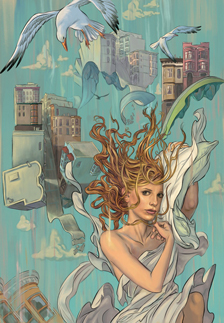Since the beginning of “Buffy,” I’ve found myself liking the characters more and more and the world they live in — the “mythology,” in geek-speak — less and less. (I’m talking in generalities; obviously, Angel’s backstory in Season 2 was a great addition to the mythology, for example.) It puts me in a weird position going into Season 9 of “Buffy” (and the corresponding “Angel & Faith”) from Dark Horse Comics, because with the whole world knowing about vampires and demons and Slayers, it doesn’t feel like those wonderful early days. But on the other hand, I love me some “Buffy” characters like never before.
So do I drop my subscription at my local comic shop and just lose myself in the sunny days of Sunnydale on DVD? Of course not: I want to find out what happens next.
From the start, I’ve liked the Scooby Gang because — like so many high school TV series main characters — they were cool uncool kids; Xander and Willow especially fit the bill. Their growing-up pains mirrored everyone’s, and they made universal pain fashionable rather than embarrassing. But here’s an open secret that adults never admit to teenagers: Life gets easier, not harder, as time goes by.
And “Buffy” Season 9, with the opening arc written by Joss Whedon himself, is intriguingly about that very thing. A bunch of crazy stuff happens at the end of Season 8 that I won’t even try to summarize here (because I don’t totally understand it). Suffice it to say that the magic is gone from the world (although the existing vampires and demons, plus Buffy’s and Faith’s Slayer status — but not all those thousands of other girls — are still in place) and the members of the gang are thinking about their futures and drifting apart.
You might say that the destruction of Sunnydale at the end of Season 7 symbolizes the loss of all of our hometowns. It’s a common young adult yearning to get out of dodge, of course, but even people who want to stay in their hometown may have to leave in order to pursue their career. As such, even though our hometowns still exist, in a way they are as gone as Sunnydale, because the ol’ gang and the ol’ hangouts (our equivalents of The Bronze, the library and the Magic Shop) aren’t there to make it exist like it used to exist.
That’s what Issue No. 1 is about: The 20-something Buffy is in San Francisco with two bohemian roommates we’ve never seen before. Reflecting the reality of California prices, she has a room so tiny that she can almost touch all the walls simultaneously, and — as we find out on the funny or stupid (debate is raging across the web) last panel — money is as tight as her living quarters.
But Buffy seems relatively happy, and not just because she does some serious boozing at a party, where she shows off her new digs to Xander and Dawn (now living together as a couple), Willow, Spike, Andrew and Riley. We’re talking full-on “Beer Bad” Cave-Buffy here, or so I surmise — we (and she) don’t actually know what she did at the party, we just know that she woke up with a hangover and vague recollections, and her boss at the coffeehouse she works at told her to take the day off. (Who says the “Hangover” plot doesn’t have much mileage to it? It was recently used on an episode of “Awkward” and now in the pages of “Buffy.”) We also know Xander imparted some sort of secret on Buffy. And that Willow believes some major ramifications from the lack of magic are forthcoming. And that Riley is now fighting human terrorists.

“Buffy” Season 9’s first issue — which wraps with Buffy doing some old-school patrolling (I love it!) gets back to basics, in that it’s about the characters more so than the monster mythology and the end of the world.
Still, I can’t ignore the thing that has gradually bugged me more and more about “Buffy” and “Angel”: That the human race now knows about the supernatural. Without a doubt, that fact has sapped the Buffyverse of some of its “one girl in all the world” flavor.
However, I’m going to bring my own subtext and try to retcon my psyche so I actually like it: The parting of the curtain on demons and Slayers can be read as a metaphor for the real-world changes between 1997 and 2011. With its recent 10th anniversary, we’ve heard a lot of talk about 9/11, and a lot of the discussion — including a powerful but non-conclusive piece in Sports Illustrated — is about how the world has changed since then. Arguably, the biggest change is that we don’t pretend anymore that there aren’t evils in the world; we’re less innocent and more pragmatic and cynical. (People who lived through previous wars and recessions will scoff at that and note the cyclical nature of civilization, but just go with it here for the sake of argument.) The outed monsters in the Buffyverse parallel terrorists, wars, unemployment and student loans.
I was at a mall the other day and feeling nostalgic for the 1990s, when malls had toy stores, book stores and music stores (all of which have since moved onto the Internet, which is generally awesome but sad as hell when you’re actually at the mall). Those were the best years of my life, just as Buffy’s sophomore year of killing metaphors — I mean monsters — with Xander and Willow probably feels to her like the best of times on some level.
But overall, life gets easier as you grow older and move past the pain of realizing this is how the world really is. That’s perhaps why Buffy is smiling so much in Issue No. 1 of Season 9 — the world sucks, but living in it is easier than it used to be, and at least she’s alive. Something’s not right with the world; she doesn’t feel it as keenly as Willow, but she trusts her best friend’s feeling. (We need that ominous note, otherwise this issue would just be a secondhand account of “You won’t believe how hammered I got last night,” and while Whedon gives his typical verve to this standard tale, it’s still not enough on its own.)
But in the meantime, it’s great to have your own place in a cool city, make a few bucks until the next time you’re laid off, get some fresh air, buy some comics online, make some new friends, surf the ‘net for instant opinions on Issue No. 1, catch up with some old friends, and slay one vampire at a time rather than figuring out how to save the world.
P.S.: It’s not clear where everyone is calling home now; are they all in S.F. with Buffy? We do know that Angel and Faith, in the pages of the aptly named “Angel & Faith,” are in London, basically running an impromptu Euro-style Angel Investigations. A lot of ex-Slayers — including the rare girls Faith counts as friends — are peeved at Angel for his role in sapping the world’s magic, and they’re gunning for him. In flashback, we see Giles on a case from his Ripper days, which is awesome, and the final page is no doubt just as controversial as the final page of “Buffy,” but much juicier. Rebekah Isaacs’ art is on par with Georges Jeanty’s on “Buffy” (both are masters at likenesses), and writer Christos Gage knows these characters and — to his credit — he resists quips and jokes more than Whedon does. Plus: Whistler! That’s right, he never was killed off, was he?
What are your thoughts the first issues of “Buffy” Season 9 and “Angel & Faith?”

